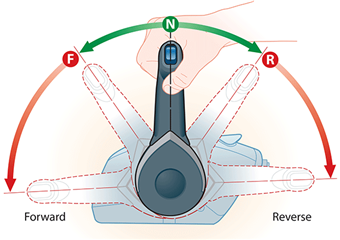
Shifting gears and throttle control are two skills that, in conjunction with steering-wheel control, will dictate how well you handle your boat. If you drive a car, you’re used to working the gears and using a gas pedal. It’s tempting to ask, how different can it really be? Well, if you’ve ever been to a busy dock area, especially on a windy day, you already know the answer.
There are a variety of shift and throttle controls on boats; some have separate controls, some combine them. Here we’ll use a control that combines both functions into a single lever.
It’s all about smoothly and decisively working the controls to avoid lurching or picking up too much speed. Sudden or excessive throttle adjustments can lead to loss of control and cause your boat to strike the dock or another boat. Your goal is to shift into gear without exceeding idle rpm. Remember, “slow is pro,” and everything you need to do to properly control your boat can be done at idle speed.
Shift decisively
Shifting from neutral should be done decisively, but without exceeding idle throttle. If you shift too slowly, you’ll hear the gears grind. If you shift too far and begin to throttle up too quickly, you’ll make the boat lunge.
If you’re moving from forward to reverse, always allow for a pause in neutral, long enough to say “one-one-thousand,” before shifting to the next gear. Shifting too quickly can cause the engine to stall or damage the transmission.
Practice makes perfect. One simple first step you can rehearse is to find the wheel and throttle by hand, without looking. This will help build muscle memory for the ergonomics of your boat. Pay close attention to the sound of the transmission as you shift gears. The change in sound of the engine as you raise or lower the throttle.
Watch how your boat responds to your shift and throttle movements, and feel where the throttle changes from forward to neutral to reverse.
When in close quarters, staying in gear too long or using too much throttle results in more boat speed than necessary. This forces the driver to take corrective action, and can easily turn into a series of over-corrections. Instead, use short applications of throttle. This should help you maintain better control of your boat’s motion, and give yourself time to maneuver. Short shifts buy you the time to decide what you need to do next.
Practice Low Speed Control
Engage forward gear at idle speed for one second only, then return to neutral to assess your situation.
Engage reverse gear at idle speed for two to three seconds only, then return to neutral to assess your situation.
When in neutral, pause several seconds so that you can assess your situation before shifting into gear.
When in gear, do not raise the throttle; stay at idle rpm